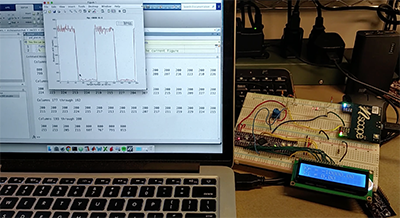ME333: Introduction to Mechatronics is a junior/senior level undergraduate and first-year graduate level course in microcontroller programming and motor control. The course was created by Professor Kevin Lynch in the Department of Mechanical Engineering in 1999; since then, it has undergone revisions to prepare students with the hands-on skills required for graduate level research and industry positions.
Starting in 2011, I partially flipped ME333 became a partially flipped course. To allow for more interaction and hands-on time in class, I recorded lectures on the Lightboard and posted them on YouTube, allowing me to move lab sessions into class time. Students purchase a lab kit and do each assignment by themselves, rather than go into a normal laboratory and share equipment with two other students. Assignments were revised so that hands-on activities with demonstrations are involved in every assignment.
A ME333 student lab kit
ME333 has grown in popularity, with an increase from 60 students a quarter in 2011 to over 100 students in 2017 (the class is offered once a year, with two sections in the Winter Quarter). I now teach both sections with the help of two TAs. Even with that help, we find it difficult to check the demonstration that each student creates for each class without losing time in class for teaching. I also wanted to allow more students greater access to teaching materials by recording parts of office hours.
I became an Educational Technology Teaching Fellow to explore new options within Canvas to address these issues.
The first technology used was Panopto for recording the questions and responses asked during office hours. I offer office hours every day and students who attend appear to perform better on assignments and in class. But due to time constraints, not every student is able to attend office hours, so it was my desire to record some of the most common questions and answers so that all of the students would have access. Panopto, paired with a wireless mic and portable webcam, allowed me to record my office hours at the white board in my lab without having to go to the Lightboard studio or One Button Studio in the library. The quality is very good, and I plan on using it again this fall when my other courses generate more attendees in office hours.
Example of a Panopto recording to answer a student FAQ posted to Canvas
The second technology I used was Arc. It allows the students to submit video demonstrations rather than present live in class. This saved over 30 minutes of class time in each section each week and reduced the stress on students by no longer requiring them to carry their projects carefully between their workspace and the classroom without damage.
Each student submitted 13 video demonstrations over the Winter Quarter for a total of about 1,300 uploaded videos. Some demonstrations were screen recordings and others were recorded by webcam, cellphone, or other camera. Some were silent and some were narrated. The camera, software, and recording techniques were left to the student to figure out. For most demonstrations, I recorded an example of how the project should perform and what the student’s video should show. Most students turned in a similar style of video.
Upon completion of the class, I asked several custom CTEC evaluation questions regarding the Arc system and video submission process in general and followed up with an anonymous survey with more questions. The CTECs had a response rate of about 57%. The overall rating of the course was about 5.05 on a scale of 1 to 6, with 1 being poor and 6 being excellent.
Asked about their impression of Arc and whether they would prefer to use a different system like YouTube, the responses were almost universally positive. Arc was commonly described as “easy.”
I found Arc easy to use and convenient to grade with SpeedGrader within Canvas. Initially I asked the students to keep their videos to 15 seconds or less, but as we graded we found it was not necessary to watch videos in their entirety. Instead it was possible to skip around in the video to find the important parts and video length was not an issue.
I am currently using Arc again in my Spring Quarter class for video demonstrations. One change I’ve made is to give the students access to Panopto so that they can use its ability to do editing and screen recording. During the fall, I will also ask the students to make two of their videos public on a platform of their choice to go along with a posting of the projects they are working on to see if the quality of the videos they post for grading privately will be different than what they post publically.
I’ve appreciated my time as an EdTech Fellow. It’s helped me stay on the cutting edge of the teaching technologies available here at Northwestern to explore more innovative and interactive activities to engage my students. CTEC questions help me to know what worked and what didn't and how I can make the experience more intuitive and efficient in future offerings of the class.

